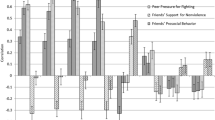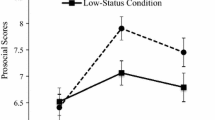Abstract
A sample of 689 adolescents (grades 7–12) from two Midwestern communities who had been identified by peers as members of one of three major peer groups responded to a self-report survey measuring perceptions of peer pressure in five areas of behavior: involvement with peers, school involvement, family involvement, conformity to peer norms, and misconduct. Perceived pressures toward peer involvement were particularly strong, whereas peer pressures concerning misconduct were relatively ambivalent. Perceived pressures toward misconduct increased across grade levels and pressures to conform to peer norms diminished; grade differences in perceived peer pressures concerning family involvement were community specific. Compared to druggie-toughs, jock-populars perceived stronger peer pressures toward school and family involvement, and less pressure toward (stronger pressure against) misconduct; patterns of perceived pressure among loners were more variable across communities. Results elaborated the process of peer influence in adolescent socialization and identity development.
Similar content being viewed by others
References
Berndt, T. J. (1979). Developmental changes in conformity to peers and parents.Dev. Psychol. 15: 606–616.
Bixenstine, V. E., DeCorte, M. S., and Bixenstine, B. A. (1976). Conformity to peer-sponsored misconduct at four grade levels.Dev. Psychol. 12: 226–236.
Bourne, E. (1978). The state of research on ego identity: A review and appraisal. Part 1.J. Youth Adoles. 7: 223–251.
Brittain, C. V. (1963). Adolesent choices and parent-peer cross-pressures.Am. Sociol. Rev. 28: 385–391.
Bronfenbrenner, U. (1967). Response to pressure from peers vs. adults: Soviet and American school children.Int. J. Psychol. 2: 199–207.
Brown, B. B. (1982). The extent and effects of peer pressure among high school students: A retrospective analysis.J. Youth Adoles. 11: 121–133.
Brown, B. B., Lohr, M. J., and McClenahan, E. L. (in press). Early adolescents' perceptions of peer pressure.J. Early Adoles.
Brown, B. B., Lohr, M. J., and Trujillo, C. M. (1985). Adolescents' perceptions of peer group stereotypes. Manuscript submitted for publication.
Buff, S. A. (1970). Greasers, dupers and hippies: Three responses to the adult world. In Howe, L. K. (ed.),The White Majority, Random House, New York.
Coleman, J. S. (1961).The Adolescent Society, Free Press, New York.
Collins, J. K. (1974). Adolescent dating intimacy: Norms and peer expectations.J. Youth Adoles. 3: 317–328.
Conger, J. J., and Petersen, A. C. (1984).Adolescence and Youth (3rd ed.), Harper & Row, New York.
Costanzo, P. R., and Shaw, M. E. (1966). Conformity as a function of age level.Child Dev. 37: 967–975.
Cusick, P. A. (1973).Inside High School, Holt, Rinehart and Winston, New York.
Dunphy, D. C. (1963). The social structure of urban adolescent peer groups.Sociometry 26: 230–246.
Erikson, E. H. (1968).Identity, Youth and Crisis, Norton, New York.
Hartup, W. W. (1983). Peer relations. In Heatherington, E. M. (ed.)Handbook of Child Psychology: Socialization, Personality and Social Development (Vol. 4), John Wiley & Sons, New York.
Hollingshead, A., and Redlich, F. (1958).Social Class and Mental Illness, Wiley, New York.
Huba, G. J., Wingard, J. A., and Bentler, P. M. (1979). Beginning adolescent drug use and peer and adult interaction patterns.J. Consult. Clin. Psychol. 47: 265–276.
Ide, J. K., Parkerson, J., Haertel, G. D., and Walberg, H. L. (1981). Peer group influences on educational outcomes: A quantitative synthesis.J. Educ. Psychol. 73: 472–484.
Jessor, R., and Jessor, S. L. (1979).Problem Behavior and Psychological Development: A Longitudinal Study of Youth, Academic Press, New York.
Kandel, D. B. (1978). Homophily, selection and socialization in adolescent friendships.Am. J. Sociol. 84: 427–436.
Kirk, R. E. (1982).Experimental Design (2nd ed.). Brooks/Cole, Monterey, Calif.
Larkin, R. W. (1979).Suburban Youth in Cultural Crisis, Oxford University Press, New York.
Newman, P. R., and Newman, B. M. (1976). Early adolescence and its conflict: Group identity vs. alienation.Adolescence 11: 261–274.
Poveda, T. G. (1975). Reputation and the adolescent girl: An analysis.Adolescence 37: 127–136.
Reynolds, W. M. (1982). Development of reliable and valid short forms of the Marlowe-Crowne Social Desirability Scale.J. Clin. Psychol. 38: 119–125.
Riester, A. E., and Zucker, R. A. (1968). Adolescent social structure and drinking behavior.Personnel Guid. J. 47: 304–312.
Schwendinger, H., and Schwendinger, J. S. (1985).Adolescent Subculture and Delinquency, Praeger, New York.
Sherif, M., and Sherif, C. W. (1964).Reference Groups, Regnery, Chicago.
Stone, L., Miranne, A., and Ellis, G. (1979). Parent-peer influences as a predictor of marijuana use.Adolescence 14: 115–122.
Varenne, H. (1982). Jocks and freaks: The symbolic structure of the expression of social interaction among American senior high school students. In Spindler, G. (ed.),Doing the Ethnography of Schooling, Holt, Rinehart and Winston, New York.
Weis, J. G. (1974). Styles of middle-class adolescent drug use.Pac. Sociol. Rev. 17: 251–285.
Author information
Authors and Affiliations
Additional information
She received her Ph.D. in 1982 from University of Wisconsin-Madison. Her research interests: adolescent peer groups and peer pressure, and implications of various instructional strategies for gifted students.
He received his Ph.D. in 1979 from the University of Chicago. His research interests: effects of peer pressure and peer-group affiliation on adolescent self-concept and identity development, and social development in high school.
Rights and permissions
About this article
Cite this article
Clasen, D.R., Brown, B.B. The multidimensionality of peer pressure in adolescence. J Youth Adolescence 14, 451–468 (1985). https://doi.org/10.1007/BF02139520
Received:
Accepted:
Issue Date:
DOI: https://doi.org/10.1007/BF02139520




